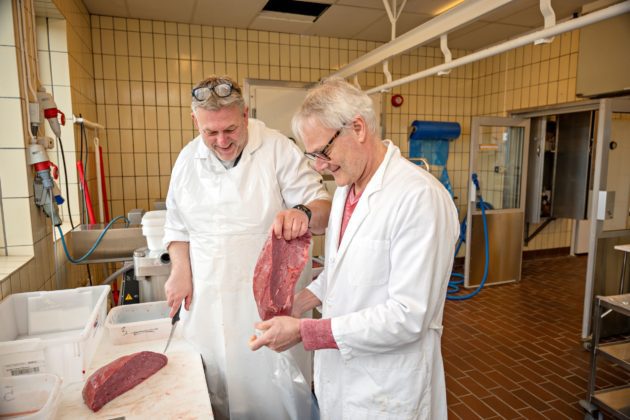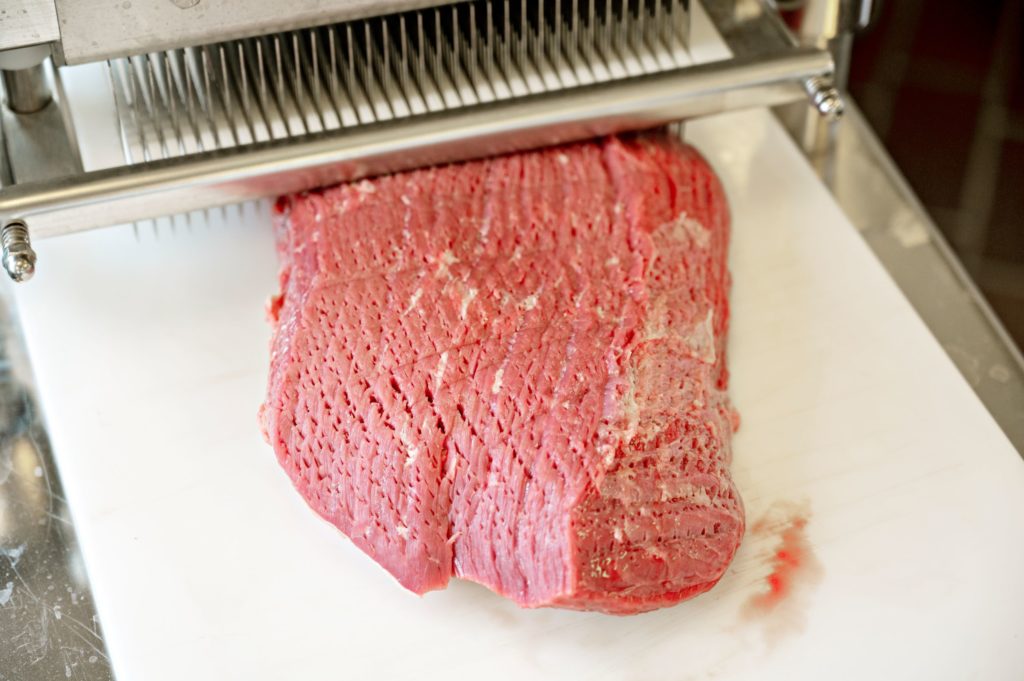Elderly people need a protein-rich diet, tenderer meat may be the solution

Many elderly people struggle to chew meat because it can be tough and dry. At the same time, meat can contribute to important proteins. At home, you can pound the meat to make it more tender. Industry can use mechanical processing.
Nofima’s experts are conducting trials on how mechanical tenderisation and various brines affect the tenderness and juiciness of beef. The results so far indicate that tougher cuts of beef as top round and eye of round can become as tender as tenderloin.
Top round and eye of round become tender and juicy like tenderloin
It is well known that meat can be made tenderer by using mechanical tenderisation, still such processing is rarely used in Norway. Mechanical tenderisation involves cutting small incisions in the meat. This gives the same effect as tenderising the meat by pounding it. In the trials conducted at Nofima, the purpose is to make cuts of beef more accessible to the elderly, but also to other groups that prefer tender and juicy meat.
Scientist Rune Rødbotten and Nofima’s sausage-making expert Tom Johannessen are now investigating how beef is affected by mechanical tenderisation. They are also testing whether the meat becomes even more tender and juicier by adding brine. They are trying out different brines, including brine with a protein mixture based on rest raw materials.
“There is a lot of water in meat, and the contents of the brine help the meat to better retain its own liquid, even during heat treatment. In many countries, it is common to add brine to ensure juicier meat”, Tom explains.
“Tough muscles have stronger connective tissue than tender ones. That is why we have chosen three muscles with different amounts of connective tissue for this trial”, says Rune.
They have processed the cuts of beef called eye of round and top round using both mechanical tenderisation and brine. Either a standard brine consisting of water, salt and phosphate, or a brine with the protein mixture in addition to water, salt and phosphate was added to top round beef. The eye of round cut was only tested using the standard brine. The samples were then served to Nofima’s professional taste judges who found clear differences between the processes.
In total, there were six samples:
- Unprocessed tenderloin
- Unprocessed eye of round
- Unprocessed top round
- Eye of round that is mechanically tenderised and had standard brine added
- Top round that is mechanically tenderised and had standard brine added
- Top round that is mechanically tenderised and had protein-enriched brine added
“It turns out that the combination of mechanical tenderisation and brine produces very good results. The tenderloin is far more tender than the other cuts of beef when they are all unprocessed, but by processing the top round and eye of round cuts using mechanical tenderisation and brine, they become just as tender and juicy as the unprocessed tenderloin”, says Rune.

Elderly people need a protein-rich diet
The trials carried out by Tom and Rune are part of the EU network project called Eat4Age, which is led by Nofima Senior Scientist Paula Varela Tomasco. The aim of the project is to develop tasty, nutritious and easily digestible food in order to prevent malnutrition in the elderly.
“Pure cuts of meat are both an important source of protein and a food that many elderly people are used to eating and that they have really enjoyed throughout their lives. However, there are also many elderly people who stop eating meat because they struggle to chew and digest it. Therefore, it is important to develop tenderer and juicier cuts of meat for this target group, providing easily digestible and highly nutritious protein, in a liked and familiar food”, says Paula.
She has been researching the diets of elderly people for a number of years, and says that the texture and so-called mouthfeel of the food, i.e. the physical sensations in the mouth caused by food while chewing, are of great importance regarding which type of food elderly people in particular prefer.
“It is not that surprising that a dry and chewy texture is not favoured by older consumers. On the other hand, they aren’t too keen on a sticky texture either. Think brioche dough; its glutinous texture makes it stick to your teeth and palate, and it is very uncomfortable for people who have difficulty swallowing or dentures. We also try to avoid slightly bitter or astringent flavours, as mouth-drying perception is sometimes enhanced in the elderly”, Paula points out.
Will also investigate other cuts of meat
Based on the results of the first test, Tom and Rune have now concentrated on the top round cut of beef, and have included more variations than in the first trial.
The following variations have now been developed, and the taste judges will soon start assessing these:
- Unprocessed top round
- Top round using only mechanical tenderisation
- Top round using standard brine and mechanical tenderisation
- Top round using protein-enriched brine and mechanical tenderisation.
It is not just the elderly who prefer tender and juicy cuts of meat. Therefore, the experts want to delve even deeper into this field of study.
“We want to find out whether other cuts of meat which currently cost less money, such as stewing beef or bottom round, can be tender enough for older palates, and tastier for others, if processed using mechanical tenderisation and the right brine”, says Tom.
Research facts
The research has been carried out in the Eat4Age network project, and has received funding from the Norwegian Research Council under the umbrella of the European Joint Programming Initiative “A Healthy Diet for a Healthy Life” (JPI HDHL) and of the ERA-NET Cofund ERA-HDHL (GA N° 696295 of the EU Horizon 2020 Research and Innovation Programme).
The project runs over three years and will end in March 2024.
In addition to Nofima, project participants include: NRAE, The Norwegian School of Sport Sciences, Technion, The University of Leeds, and Teagasc Food Research Centre. Nortura and GatFoods.


